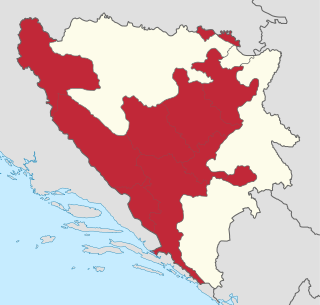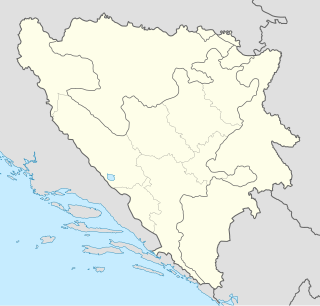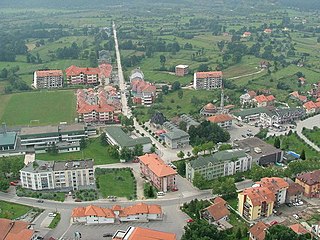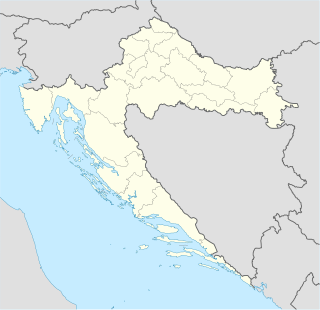
The 1895 population census in Bosnia and Herzegovina was the third census of the population of Bosnia and Herzegovina taken during the Austro-Hungarian occupation [1]

The 1895 population census in Bosnia and Herzegovina was the third census of the population of Bosnia and Herzegovina taken during the Austro-Hungarian occupation [1]
Population of Bosnia and Herzegovina in 1895
| Type | Number | Percentage | Number change | Percentage change |
|---|---|---|---|---|
| Orthodox Christians | 673,246 | 42.94% | ||
| Sunni Muslims | 548,632 | 34.99% | ||
| Catholics | 334,142 | 21.31% | ||
| Jews | 8,213 | 0.52% | ||
| Others | 3,859 | 0.24% |

Bosnia and Herzegovina, abbreviated BiH or B&H, sometimes called Bosnia–Herzegovina and often known informally as Bosnia, is a country in South and Southeast Europe, located within the Balkans. Sarajevo is the capital and largest city. Bosnia and Herzegovina is bordered by Serbia to the east, Montenegro to the southeast, and Croatia to the north and southwest. It is not entirely landlocked; to the south it has a narrow coast on the Adriatic Sea, which is about 20 kilometres long and surrounds the town of Neum. The inland Bosnia region has a moderate continental climate, with hot summers and cold, snowy winters. In the central and eastern interior of the country the geography is mountainous, in the northwest moderately hilly, and in the northeast predominantly flatland. The smaller southern region, Herzegovina, has a Mediterranean climate and mostly mountainous topography.

This article is about the demographic features of the population of Bosnia and Herzegovina, including population density, ethnicity, education level, health of the populace, economic status, religious affiliations and other aspects of the population.

The Federation of Bosnia and Herzegovina is one of the two entities that compose the State of Bosnia and Herzegovina, the other being Republika Srpska. The Federation of Bosnia and Herzegovina consists of 10 autonomous cantons with their own governments and legislatures.

Vogošća is a town and a municipality located in Sarajevo Canton of the Federation of Bosnia and Herzegovina, an entity of Bosnia and Herzegovina. The municipality is located about 6 kilometers north of the city of Sarajevo and is its secondary suburb, after Ilidža. According to the 2013 census, the town has a population of 10,568 inhabitants, with 26,343 inhabitants in the municipality.

Ploče is a town and seaport in the Dubrovnik-Neretva County of Croatia.

Lukavac is a town and municipality located in Tuzla Canton of the Federation of Bosnia and Herzegovina, an entity of Bosnia and Herzegovina. According to the 2013 census, the town has a population of 12,061 inhabitants, with 44,520 inhabitants in the municipality.

Živinice is a city located in Tuzla Canton of the Federation of Bosnia and Herzegovina, an entity of Bosnia and Herzegovina. It is located in northeastern Bosnia and Herzegovina, south of Tuzla. As of 2013, it has a population of 57,765 inhabitants.

Kalesija is a town and municipality located in Tuzla Canton of the Federation of Bosnia and Herzegovina, an entity of Bosnia and Herzegovina. It is located in northeastern Bosnia and Herzegovina, east of Tuzla. As of 2013, the town has a population of 2,039 inhabitants, and the municipality has 33,053 inhabitants.

Vitez is a town and municipality located in Central Bosnia Canton of the Federation of Bosnia and Herzegovina, an entity of Bosnia and Herzegovina. According to the 2013 census, the town has a population of 6,329 inhabitants, with 25,836 inhabitants in the municipality.

This article is about the Demographic history of Bosnia and Herzegovina, and deals with the country's documented demographics over time. For an overview of the various ethnic groups and their historical development, see Ethnic groups in Bosnia and Herzegovina.

The Croats of Bosnia and Herzegovina, often referred to as Bosnian Croats or Herzegovinian Croats, are the third most populous ethnic group in the country after Bosniaks and Serbs, and are one of the constitutive nations of Bosnia and Herzegovina. Croats of Bosnia and Herzegovina have made significant contributions to the culture of Bosnia and Herzegovina. Most Croats declare themselves Roman Catholics and speakers of Croatian.
The Turks in Bosnia and Herzegovina, also known as Bosnian Turks, are ethnic Turks who form the oldest ethnic minority in Bosnia and Herzegovina. The Turkish community began to settle in the region in the 15th century under Ottoman rule, however many Turks emigrated to Turkey when Bosnia and Herzegovina came under Austro-Hungarian rule.

Vranovina is a village in the municipality of Bosanski Petrovac, Bosnia and Herzegovina.

Stijena is a village in the municipality of Cazin, Bosnia and Herzegovina.
Bosnians are people identified with the country of Bosnia and Herzegovina or with the region of Bosnia. As a common demonym, the term Bosnians refers to all inhabitants/citizens of the country, regardless of any ethnic, cultural or religious affiliation. It can also be used as a designation for anyone who is descended from the region of Bosnia. Also, a Bosnian can be anyone who holds citizenship of the state of Bosnia and Herzegovina and thus is largely synonymous with the all-encompassing national demonym Bosnians and Herzegovinians. This includes, but is not limited to, members of the constituent ethnic groups of Bosnia and Herzegovina: Bosniaks, Serbs, and Croats. Those who reside in the smaller geographical region of Herzegovina usually prefer to identify as Herzegovinians.
The most recent census of Bosnia and Herzegovina, the 2013 census, took place from 1 October until 15 October 2013 with a reference date of census 30 September 2013 at 24:00 hours (midnight), 22 years after the previous census. It was the first census after the Bosnian War. It was organized by the Central Census Bureau of Bosnia and Herzegovina and supported by the European Union.
The 1910 population census in Bosnia and Herzegovina was the fourth census of the population of Bosnia and Herzegovina taken during the Austro-Hungarian Condominium of Bosnia and Herzegovina

Bušević is a village in Croatia.

Begluci is a village in Croatia.